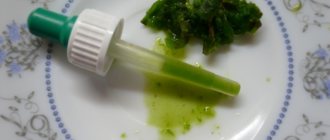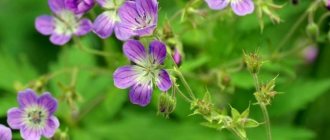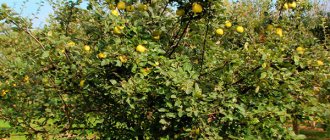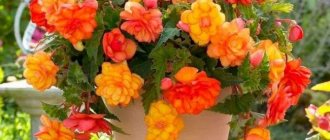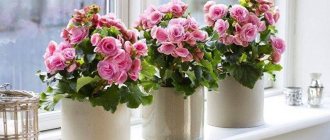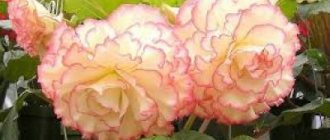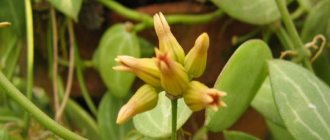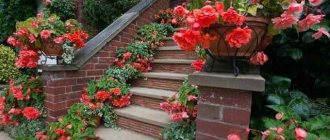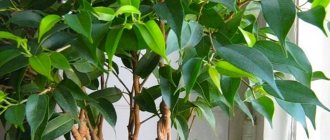Botanical description
Represents the division of flowering plants, the class of dicotyledons, the order Cucurbitaceae, the family Begoniaceae, the genus Begonia.
It appeared in Europe at the end of the 17th century, thanks to the botanist Plumier. The name comes from Begon, a member of the expedition who organized the trip to the islands of South America.
Ampelous begonia is a small bush up to 30 centimeters tall, hanging shoots reach a length of 45 centimeters. The self-limiting stems contain asymmetrical green leaves. The flowers are large, 6 centimeters in diameter. They are monoecious, unisexual, and have bright colors:
- pink;
- red;
- orange;
- multicolor.
The flowers remain on the plant for about 10 days, then fade. They are replaced by new buds. This continues for a long period of flowering. Outdoors, begonia begins to bloom from July until frost. At home, the culture pleases with flowering all 10-12 months.
Begonia at home care
Growing Begonia: Lighting and Temperature
Begonia prefers bright, sparse light, so it grows well in summer in eastern and western windows, and in winter in southern windows. If your begonia is too stretched, it does not have enough light, and if its leaves dry out and burns appear on them, then the sun's rays are too hot and the begonia should be moved to another place. In general, royal begonias and other decorative deciduous species require less light than bush begonias. If your bathroom has windows with bright light, then it may be an ideal location for indoor begonias. See also: House plants for the bathroom.
The temperature for keeping domestic begonias is 18-23 degrees.
Watering begonias
Water the begonia when the surface of the substrate has dried a couple of centimeters deep. After watering the begonia generously, let the water drain completely. If the substrate with begonia is completely dry, then watering it using the usual method is useless; you will need to soak the pot in water for a couple of hours. Be sure to drain the water completely before placing your begonia in the planter.
Air humidity for begonias
When growing begonia (like many other subtropical and tropical plants) at home with central heating, the main problem is air humidity. To increase air humidity, use a spray bottle to spray the air around the begonia (it is better not to spray the plant leaves themselves), use air humidifiers and place the begonia pot in a larger pot, the bottom of which is filled with wet gravel. Make sure the water in the planter does not touch the bottom of the begonia pot.
Begonia fertilizer
During the growth period (spring-summer), it is recommended to fertilize begonia with a weak solution of mineral fertilizer for house plants about once a week or less. From mid-autumn to early spring, feeding decorative deciduous begonias is stopped. Winter-flowering begonias continue to be fed until the end of flowering, but the complete fertilizer is changed to phosphorus and nitrogen is completely excluded.
Varieties and photos
Below are photos, names and descriptions of ampelous begonia varieties suitable for planting and care at home.
Chanson
An ornamental plant, distinguished by double, semi-double inflorescences. Consists of 5-7 large processes ranging from 30 to 45 centimeters long . It blooms profusely, for a long time, the leaves of the flowers are wide and brightly colored. There are unusual double colors. Graceful hanging shoots look elegant in hanging baskets, flowerpots, tall flowerpots, where the plant can show its ampelous shape.
The flower gradually grows tubers, which are well preserved for the next season. The plant loves sunlit areas, but is tolerant of partial shade. It prefers soil rich in organic matter and responds well to frequent moisture. The photo below shows Begonia Ampel Chanson:
Golden Balcony
Suitable for decorating recreation areas - garden plot, loggia, room. It produces many buds at once, blooms profusely, for a long time, for several months. Does not lose the brightness of flowers for a long time. When placing a plant outdoors, you need to protect it from drafts. If the crop is always indoors, it is necessary to ensure a flow of fresh air.
The variety prefers shady places or diffused sunlight. You should water generously, but do not overdo it . When it has bloomed, you need to gradually stop watering. Then cut off the above-ground part and leave the nodules for storage, moistening the soil from time to time. In the spring they are planted in a new substrate, fertilizer is added and watering is resumed. You can see what the Begonia Ampelnaya Golden Balconi variety looks like in the photo below:
Scarlett
A spectacular, beautiful variety, 25 cm high with double flowers. Their petals have a diameter of 18-20 centimeters. The flowers are peony-shaped, rose-shaped, camellia-shaped, narcissus-shaped and fringed. In good light, the entire bush is covered with flowers. Needs fertilizing for good growing season and full flowering. In March, the flower is fed twice with nitrogen fertilizers.
When the plant begins to bloom, it is advisable to add minerals without exceeding the dosage. You can feed the crop with organic matter in the summer. Before doing this, be sure to moisten the soil. The plant should be planted in a light and nutritious substrate. The finished mixture is sold in stores. Propagated by dividing the tuber, cuttings, and seeds. In the photo below is the Begonia Ampelnaya Scarlett variety:
How to easily propagate begonia
Ampelous begonia is propagated in three ways: by seeds, stem cuttings and by dividing tubers. Each of them has its own characteristics.
Seed method
In many cases, growing ampelous begonia from seeds is the only way to obtain plants with the desired shades of flowers and leaf shapes in sufficient quantity.
The method involves sowing seeds into a loose, well-moistened substrate. For sowing, slightly acidic soil with a reaction close to neutral is used. The easiest way to get it is by mixing turf, leaf soil and sand in equal proportions.
To minimize the risk of seed damage from mold, the soil substrate should be pre-treated with boiling water or calcined in an oven.
Seeds for seedlings are planted from late December to mid-January, or from April to May.
The extremely small size of the seeds of this beautifully flowering plant makes it difficult to sow evenly. Therefore, it is better to sow them on pre-moistened soil.
To simplify the task, many manufacturers offer granulated seeds covered with a water-soluble coating. It is convenient to plant them in cassette-type seedling containers, planting 1-2 granules in each cell. To speed up the dissolution of the covering shell, each granule just needs to be pressed more tightly onto the earthen clod.
To speed up the germination of seeds, it is better not to cover them with even a thin layer of soil. To create a greenhouse effect, it is better to cover the container with sown seeds with film or glass.
Advice: it is better not to water seeds evenly distributed over the surface of the earth so that the water does not drag them down to depth.
It will not be difficult to obtain friendly shoots if you maintain the temperature in the planting room around +24 or +25°C.
At the stage of seed germination, which lasts 8-9 days, the optimal temperature is considered to be in the range from +21 to +25°C.
Caring for sprouts is the same as for other plants with small seeds. The first shoots should be protected from drying out of the soil and direct sunlight. It is better to water tender shoots through a tray, using water at room temperature.
To compensate for the lack of natural light in the immediate vicinity of the seedlings, it is worth installing an artificial light source. It will allow you to extend daylight hours for seedlings to 12-14 hours.
Seedlings of ampelous begonia grown from seeds turn out strong and healthy. To stimulate the growing season, it is picked at the age of 50-60 days, planted in containers for the permanent “place of residence” of the plant.
A couple of weeks after picking, the bushes are fed with complex fertilizers. Plants can be planted in the ground at the age of 20-22 weeks. With the seed propagation method, this occurs at the end of May - beginning of June.
Growing stem cuttings
Propagation by cuttings is advantageous in terms of ease of execution and the possibility of preserving the characteristics of the variety. It can be produced throughout the year. But the best rooting is demonstrated by cuttings planted in spring. To do this, several cuttings 10 cm long are cut from an overwintered plant. The lower part of the cuttings is placed in water and left for 8-10 days. During this period, small white roots form. Cuttings with sprouted roots are planted in nutritious, well-moistened soil. For better rooting, they need to be watered regularly with warm, settled water.
To form a lush bush, several cuttings are planted in one pot at once. To make it more branchy, pinch the tops of the cuttings. But in this case, you should be prepared for the fact that the flowering of “pinched” cuttings will be delayed for 2-3 weeks.
Tuber division
The characteristic features of the mother plant are well preserved even when dividing the tubers. To implement this method, old tubers with 7-10 “dormant” buds are used. They are divided into several segments so that each has 2-3 buds. The cuts should be made correctly with a sharp knife from top to bottom. The segments are dried for 2-3 days and then planted in the ground.
When growing ampelous begonia, the tuberous planting material is kept with its convex side placed on moistened fabric or soil mixed with sand. Tubers are planted in a permanent location at the stage when they have formed tiny white roots. They are laid out in pots filled with soil, placing them with the convex side. The space around the tubers is sprinkled with earth and lightly compacted. It is important that the top of the planted tuber is located a couple of centimeters below the edge of the pot.
Planted tubers of hanging begonia should not be sprinkled with a thick layer of soil until sprouts appear. It is better to do this at the stage of blooming of the third leaf. The development of the tuberous root occurs most quickly at a temperature of +14°C. All that remains is to transplant the rooted tubers to a permanent “place of residence” in a container and feed them with complex fertilizers.
Otherwise, caring for hanging begonias is the same as caring for other beautiful flowering plants. The plant must be inspected for dried leaves and wilted flowers, and also be monitored so as not to miss the appearance of pests.
Begonia grown at home prefers to do without close proximity. She loves space and does not tolerate it when someone moves her to a new place or simply touches her often.
Care
Ampelous begonia is loved by flower growers for its attractive appearance and variety of shapes. It is easy to care for and does not require special maintenance conditions. The plant should not be replanted frequently; the temperature should be moderate. A little more attention is paid to maintaining air humidity; the inhabitant of the tropics cannot stand dryness.
Location and lighting
Begonia loves good light, but you don't need to place it in the sun. Flowering plants prefer diffused light, and decorative deciduous plants prefer shading . It is best to place a flower pot on the east or west side. In winter, daylight hours decrease, so the plant should be artificially illuminated.
It is not difficult to maintain the required temperature regime for hanging begonia. The only caveat is to make sure that there are no temperature fluctuations.
In summer, it is advisable to keep the flower at temperatures of +22-25 degrees. In winter, the air temperature should be lowered to +14-18 degrees.
Watering and air humidity
If the soil is dry, loosen it and pour the liquid into the pan. That's right, place the pot in a basin of water, wait until the earthen ball is completely saturated . Then the pot is placed on a tray to drain excess moisture. How much to water the crop will be determined by the conditions in which the plant is kept: on a southern windowsill or loggia, gazebo.
On the street it is necessary to moisturize daily, in the room, on a shaded balcony - every other day. You need to focus on the condition of the soil.
It is advisable to water with softened water. To do this, it must be filtered and allowed to stand for 12 hours. There is another way - using peat soil: tie 0.5 kg of peat in a “knot” and lower it into 4 liters of water. Leave for 24 hours.
The flower needs moisture, but you should not spray water on the leaves . There are other ways to moisturize: place containers of water near the flower pots. You can pour peat, sand or moss into the tray and constantly moisten them. In winter, place a wet towel on a hot radiator.
Temperature
The flower tolerates temperatures well from +16 to +26 degrees. Although the optimal range is from +17 to +22 degrees.
It is advisable to avoid exposure to temperatures of +10 and below. But heat is also detrimental to bud setting.
Top dressing
Begonias react negatively to the transition from one season to another. On autumn and winter days there is less light and heat on the window. The flower pauses its growing season. During this period, the plant needs feeding. Otherwise, the stems stretch, the leaves become brittle and are susceptible to attack by pests and diseases. The addition of nutrients depends on the season.
| Season | Frequency of application | Fertilizers |
| Spring, autumn | weekly | Begonia with color : "Fertmix" - 1 cap per 1 liter of water, "Fertika Lux" - 15 g, per 8 liters, "Energen" - 3 ml per liter of water, or any complex of fertilizers. Leaf begonia : Universal “Mr. Color”, “Ficus” - 1 cap per 1 liter of water, “Novofert” - 3 grams per 1.5 liters of water, etc. |
| Summer period | Once every 14 days | |
| Winter period | 1 time per month |
Transfer
The hanging plant is replanted once every 4 years. This is done in early spring, in March. Changing the container is required when the roots become cramped in the old pot. The new container is selected to be 2 or 3 cm larger in diameter.
When replanting, you need to carefully remove the plant and clean the roots from the old soil. Then the flower is placed in a slightly pink solution of potassium permanganate for 60 minutes. Then the roots are carefully examined for the presence of gili and pests. The affected areas are cut out to clean tissue. Then I lower the culture into a new pot and cover it with fresh substrate. The top layer is lightly pressed in a circle.
Priming
For hanging varieties, it is better to take nutritious soil. You can buy ready-made soil at the store or mix it yourself .
Take 2 parts of leaf humus, 1 part of peat and 1 part of black soil. The container is filled like this: the bottom is covered with coarse sand, on top of it. On it is a layer of rotted leaves, and the last layer is a mixture of black soil and peat soil. Fertilize the plant during budding and flowering, twice a month. You can use ready-made mineral fertilizer complexes.
Trimming
This process is especially important for the plant. Without pruning, it is impossible to grow a beautiful and healthy crop. The formation of a bush is done not only to rejuvenate the begonia, but also to give it an aesthetic appearance. When growth is not controlled, the flower grows “gnarled.” Its stem becomes elongated and its shoots thin. The plant blooms poorly, the leaves become smaller.
By pinching, the ampelous begonia blooms lushly, the crown becomes dense. The flower looks well-groomed and acquires a rich color. It is advisable to prune in the fall, in October . This period is the most optimal, since from the end of February begonia begins its growing season after winter dormancy. Six months is enough for her to gain strength and bloom beautifully in the summer.
Shortening the stems must be done above the bud directed outward.
Winter period
In the cold season, hanging begonia requires careful care.
This applies to evergreen plants. They need a room temperature within + 16–23 °C. Watering should be reduced and air humidity maintained . You can place wet rags on heating radiators or place an air humidifier in the room.
The tuber crop begins preparation for the dormant period in October, when the leaves dry and fall off. At this time, watering stops, and the pot with the dead upper part is transferred to a cool place. There the plant remains dormant until the end of winter. When the flower itself does not go into a dormant state by November, they stop watering it and remove the stems to the ground.
For proper flowering of begonia in the future, you need to keep the plant in winter at the optimal temperature for this crop. During dormancy, water 2-3 times to prevent the tubers from drying out.
Features of planting
To get a healthy, beautifully flowering plant, it is important to choose the right planting material. The begonia tuber must be large, at least 4 cm in diameter, without dark spots, concavities, soft areas and other signs of fungal infections. On the top of the tuber you can see tubercles - future buds, of which there should be 3 or more.
The optimal soil for begonia should have a slightly acidic reaction, be loose, moisture- and breathable, and at the same time nutritious. This can be achieved by mixing 4 parts of leaf soil, 1 part of high-moor peat and 1 part of sand. It is advisable to add perlite to the mixture for better moisture exchange. If you replace high peat, which has an acidic reaction, with neutral coconut fiber or lowland peat, the soil is additionally acidified with chopped sphagnum moss.
The pot for begonia is chosen based on the characteristics of the bush and root system, low and wide. If you plan to hang the bushes, the containers should be equipped with fixed trays. This way you don’t have to worry about excess water spilling. Ampelous begonias look great in flowerpots with high legs.
Before planting, the tubers are laid out with their bottom sides on trays with wet sand or peat. You can use a soft cloth. The main thing is to maintain a high level of humidity, while avoiding direct contact of the tubers with moisture. Containers with planting material are exposed to light. Periodically they are sprayed with Epin, Zircon or another root formation stimulator and a weak solution of potassium permanganate. When small roots appear on the convex part of the tubers, they are ready for planting. At a temperature of 20-25 degrees, the preparatory stage takes about a week.
Planting tubers is not difficult:
- In a prepared pot with a diameter of 12 cm, place a layer of drainage and soil so that 1/4 of the container remains free.
- The soil is watered abundantly.
- The tuber is placed on the ground, slightly pressing. If you plant several specimens in one pot, there should be 4-5 cm of free space between them.
- Freshly planted tubers should never be covered on top.
- The pots are placed in a well-lit, warm place.
- Before sprouts appear, water carefully, trying to avoid water getting on the tubers.
- After the sprouts grow to 5 cm and become stronger, you can add more soil on top.
If you cover the tuber earlier, the sprouts will not hatch. Therefore, wait until all the kidneys awaken. An adult strong tuber is capable of “stretching” up to 7 shoots. It is better to remove the excess ones immediately. The soil level above the tuber should not exceed 3 cm. After a month, the bush is transferred to a pot with a diameter of 20 cm.
We recommend reading
Home care for Hyacinth in a pot
Home care for Chrysanthemum in a pot
Home care for Kalanchoe
Caring for a Venus flytrap flower at home
Reproduction
Ampelous begonias reproduce in three ways: cuttings, seeds, and cutting tubers into pieces.
Propagation by cuttings
For propagation by cuttings, a 12-centimeter long segment is taken, along with the top. Be sure to sprinkle the cut area with sifted ash or crushed coal. Place the planting material in a container with a moistened begonia substrate and cover with a glass jar. When the soil dries out, pour water into the pan, as for an adult plant. The survival rate of hanging begonia cuttings is good, everything happens within 30 days.
The cuttings that have begun the growing season are gradually accustomed to the room temperature. First, lift the jar and place a piece of wood under the edge. This is how the mini-greenhouse will be ventilated.
After three days of preparation, the jar can be removed completely. If the graft does not survive successfully, it is worth repeating the operation. Begonias with stems are propagated using this method.
Growing from seeds
Ampelous begonia propagates well from cuttings, so growing from seeds is not often used. It happens that flower growers use this method when there is insufficient planting material. Seeds can be purchased in a special store, from collectors. The seeds are sown in mid-winter so that the plant blooms by July . To do this you need:
- distribute the seeds on the surface of a moistened substrate or in peat pots;
- the seeds are pressed to the ground, but not covered with soil;
- cover the plantings with cling film, make a greenhouse from a container with a lid and other options;
- shoots should appear by day 14;
- from pulling sprouts, illuminate the plants with fluorescent lamps;
- When 2 true leaves appear, plant the begonia in a separate pot.
Planting tubers
Tuberous begonia reproduces well by cuttings or leaves. Planting by dividing a tuber is a risky operation; the entire plant may die. How to divide an adult plant :
- In February, dig up the tuber.
- Disconnect young children and seat them separately.
- The tubers are divided in such a way that a sprout is present on each part.
- The cut area is sprinkled with crushed coal and ash from burnt wood.
- Plant parts of the tuber halfway into the ground, with the sprout facing up.
- Cover with film or a glass jar and constantly moisten the soil.
- When the stems grow to 7-8 centimeters, bury the entire nodule.
Indoor culture of tuberous begonias
At home, tuberous begonia, purchased as seedlings in a pot, will bloom in the summer in a fairly bright window, but not in the sun. If the pot is placed in soil or peat and watered moderately, this will provide normal humidity for growth and flowering.
If tuberous begonia is shaded too much or pots are placed on northern windows, it stretches out and loses its decorative effect.
Begonias bloom much better in boxes on a shady balcony or on the balcony floor. Plants in pots and boxes require regular feeding with complete complex fertilizers. In such conditions, begonias grown from tubers feel better and bloom more profusely.
Diseases and pests
Ampelous begonia often suffers from gray rot and powdery mildew. The first helps with a solution of copper sulfate with the addition of laundry soap. Powdery mildew is destroyed with the drugs “Morestan” and “Fundazol”. The plant gets sick due to:
- Abundant and frequent watering. As a result, the leaves turn yellow, crumble and rot.
- Lack of lighting, causing the foliage to become spotted.
- Too dry air in the room leads to the falling of buds and leaves.
- Excessively high temperature, the result is wilting of the leaves.
- The flower is often attacked by harmful insects: greenhouse aphids, scale insects, thrips, whiteflies, spider mites and others.
To prevent and cure plant diseases and protect them from pests, fungicides are used.
Complex products are considered the most effective: “Fundazol”, “Topaz”, “Maxim”, “Fitosporin-M” and others.
Varieties of ampelous begonia
There are many dozens of plant varieties, and almost all of them are of hybrid origin. That is, all these plants were specially bred by breeders and adapted to the peculiarities of our climate. In everyday life, varieties of this flower are often named by color: for example, white ampelous begonia.
Although, of course, there is a scientific classification. As a rule, breeders distinguish series, within which specific varieties are distinguished. For example, the “Chanson” series includes the following varieties:
- white;
- salmon;
- pink;
- vanilla yellow;
- copper and many others.
When breeding a specific variety, it is important to consider that propagation methods such as cuttings, growing from a tuber, or dividing a bush will produce an exact copy of the mother plant. But propagation by seeds does not guarantee 100% similarity with the parent.
Photo gallery
aromatcvetov2018
dashin_sadik
ludmila_vinyarskaya_art
ajgultursunova5
agroflower
gurianova382
Features of growing begonias from cuttings
Planting begonia cuttings is not particularly difficult. But to get the best results, it is better to use the following recommendations:
- Begonias are photophilous, but direct sunlight burns them. Immediately after transplanting, it is better to place the flower in partial shade for a couple of days to make it easier for it to adapt.
- Cuttings and leaves are rooted one at a time. In the same pot they will touch each other, interfere, and the process of rotting may begin. Containers for seedlings cost a penny, because you can use ordinary disposable cups, so try to give the seedlings a separate “room”.
- After transplanting the begonia to a permanent place, it is better not to move the pot for several days.
- Do not overwater begonias - these plants like regular but moderate watering.
Briefly about the plant
Typically, hanging begonia is grown in hanging flower pots and flowerpots. It is used to decorate verandas, gazebos, and arches. Plants that are grown outdoors require careful care, unlike indoor flowers.
Ampelous begonia has tuberous roots, stems 20–60 centimeters long, large leaves 10–15 centimeters long.
The plant blooms with unisexual, numerous, large single or double flowers. The first thing you can see on a terry begonia is simple flowers that have blossomed; after a while, double flowers also begin to bloom.
